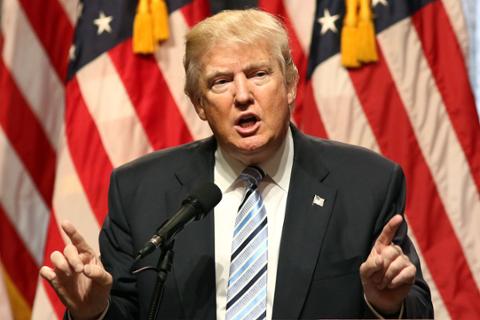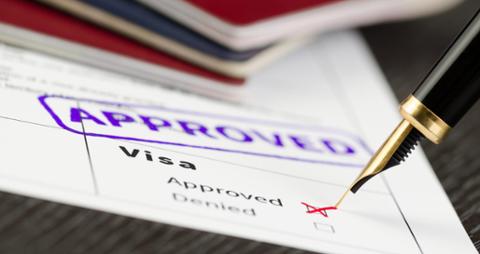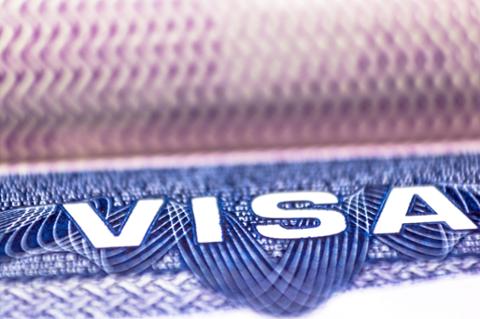Last month, President Trump introduced a sweeping immigration reform plan. One of the plan’s proposals would fundamentally alter how tech firms source high-skilled workers from other countries. But the proposal seems grievously at odds with the Trump administration’s recent work in curtailing the H-1B and other visas.
Under Trump’s proposal, the nation’s immigration system would become “merit-based,” with an emphasis on selecting immigrants who exhibit “extraordinary talent,” “professional and specialized vocations,” and “exceptional academic track records.”
“The President’s proposal will increase American competitiveness in attracting and retaining the best and brightest by moving the United States in line with the effective point systems used by other countries,” read the White House’s press release, which included a chart showing how Canada, New Zealand, Australia, and Japan supposedly all issue a majority of their visas on the basis of skill and employment.
Right now, the U.S. selects 12 percent of immigrants on the basis of skill and employment, 66 percent on family ties, and 21 percent on “humanitarian/diversity lottery/other.” The Trump plan would shift that to 57 percent of visas issued due to skill and employment, 33 percent family, and 10 percent humanitarian.
If this Trump proposal comes to pass, that shift in percentages would obviously prove devastating for many families trying to immigrate to the United States. However, it would benefit those tech firms seeking to land as much high-tech talent as possible. Although critics claim that visas such as H-1B allow companies to undercut the salaries and opportunities of U.S. citizens, the White House’s release implies that these changes to the system will somehow improve on a current system that “undercuts wages and drains our social safety net programs.”
There’s just one issue: Trump’s proposal runs somewhat contrary to the moves his administration is already making to restrict H-1B visas.
Recent data from U.S. Citizenship and Immigration Services (USCIS) shows that the approval rate of H-1B petitions has dipped significantly since late 2016. At the same time, the percentage of H-1B applications hit with requests for evidence (RFEs) has risen steadily. In other words, the Trump administration’s various moves against H-1B—such as a longtime suspension of premium processing—have clearly had an impact.
Then there’s the decision to kill the H-4 EAD, which allows the spouses of H-1B visa holders to work in this country; USCIS called that move “economically significant”:
“Some U.S. workers would benefit from this proposed rule by having a better chance at obtaining jobs that some of the population of the H-4 workers currently hold, as the proposed rule would no longer allow H-4 workers to enter the labor market early.”
If you take away the ability of H-1B visa holders’ spouses to work, some candidates who don’t want to leave their families behind (or who don’t think they can survive without their spouse’s income) won’t undergo the H-1B process. To be fair, it seems unlikely that the move will reduce the overall number of H-1B applications in the long run—the application cap is seemingly hit faster and faster every year. Nonetheless, killing the H-4 EAD could chill some folks’ desire to immigrate.
That Confusing Trump Tweet
Despite these restrictions, though, Trump has actually exhibited some support for the concept of H-1B visas. Earlier this year, he Tweeted that “changes” to program would “bring both simplicity and certainty to your stay,” as well as a “potential path to citizenship.” (It came at an especially odd time, as USCIS was in the midst of a policy squeeze on H-1Bs.)
H1-B holders in the United States can rest assured that changes are soon coming which will bring both simplicity and certainty to your stay, including a potential path to citizenship. We want to encourage talented and highly skilled people to pursue career options in the U.S.
— Donald J. Trump (@realDonaldTrump) January 11, 2019
The confusion over the government’s ultimate intentions may only increase later this year, should USCIS succeed in its plan to “invert” the current H-1B lottery system.In the current configuration, applicants are placed in a “master’s cap” pool (of 20,000 visas), and those who aren’t accepted in the first round are placed in the “general pool” of 65,000 visas. That would change so that all H-1B applicants, including those with advanced degrees, would enter the “general pool”; any remaining applicants with advanced degrees would head into the “master’s cap” pool. In theory, flipping the pools would give those with a master’s degree or higher two successful shots at a successful H-1B application.
So is the U.S. government attempting to restrict the number of high-tech workers entering this country, or trying to open the floodgates? It seems stunningly unclear at the moment; there are conflicting messages, depending on whether you're following USCIS's data or listening to Trump's White House (and Trump himself).



